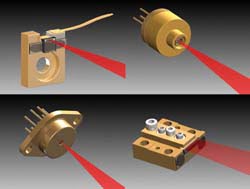if you are willing to treat ir with the respect it deserves, then you have three options co2, solid state, or diode. Co2 can achieve the highest power continuous wave laser you can get, however the bare tubes require a high voltage PSU and water cooling. I would not recommended co2 to anyone new to lasers or hv (i wouldn't recommended any of these to someone who doesn't have the sense to while using a 450mW green laser). Solid state lasers have enormous power for a very short amount of time. some solid state systems will deliver 200mJ which my not sound like mush but in 4ns, that is 50KW. Even if the solid state laser is visible, it will blind you many times over before you can blink. The 808nm laser you mentioned is a diode based laser, diodes can be incredibly compact and powerful with diode bars reaching above 100W of continuous wave laser radiation. Diode bars need cooling, usually by TEC or water cooling, they need lots of power (I've seen diodes that run in excess of 100amps), and due to their horrible beam properties they require a large amount of optics to get anything reasonable. these lasers can and will blind you if misused. Safety glasses are a MUST i cannot stress this enough. Even diffuse reflections will cause permanent blindness. Please, if you are going to buy one of the aforementioned lasers, treat it with the utmost respect.





